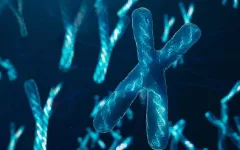(Press-News.org) (Memphis, Tenn.— Sept. 20, 2023) Hyperdiploidy is a genetic condition observed in cancer cells, where the cells contain more chromosomes than usual. The condition is particularly prevalent in childhood B-cell acute lymphoblastic leukemia (B-ALL), the most common form of pediatric cancer. To bring clarity to the field, researchers at St. Jude Children’s Research Hospital worked to better define this type of ALL in the context of modern therapy to more accurately predict patient outcomes and guide treatment decisions. The findings were published today in the Journal of Clinical Oncology.
Currently, oncology centers worldwide use at least six different definitions of hyperdiploidy to guide treatment protocols, resulting in variable patient outcomes. While physicians agree that hyperdiploidy is associated with a generally favorable outcome, the exact definition is still debated. Establishing the most optimal classification of hyperdiploidy can standardize care for childhood B-ALL and ensure patients with this cancer receive only the necessary treatments, potentially reducing the side effects of chemotherapy while improving long-term outcomes.
Better predictions, improved treatment
The St. Jude researchers compared existing methods for defining hyperdiploidy, and they discovered that DNA index, a measure of total DNA in leukemic cells, could effectively classify and predict outcomes for hyperdiploid leukemia.
“Hyperdiploidy definitions have historically been derived from the retrospective studies of previous protocols,” said co-corresponding author Ching-Hon Pui, M.D., Departments of Oncology, Pathology and Global Pediatric Medicine. “By comprehensively comparing six different classification methods in the same patient cohort, we show that a simple system, such as the DNA index, is optimal for stratifying patients with a good prognosis. This approach remains applicable in modern studies with contemporary risk-directed therapies.”
DNA index casts a wider net over the hyperdiploid patient population, making it a valuable starting point for those working in resource-limited settings that may have finite access to more expensive methods, such as whole-genome sequencing. This finding holds significance for medical centers around the world.
“The DNA index seems advantageous over other classification criteria because it captures a significant proportion of patients with excellent prognoses who are missed by a few other hyperdiploid definitions,” said co-corresponding author Jun J. Yang, Ph.D., Departments of Pharmacy and Pharmaceutical Sciences and Oncology.
Patients with good prognoses have specific drug sensitivities
While DNA index is highly informative of treatment outcomes, it has limitations — it cannot identify the specific chromosomes that have been gained. This study also found that not all trisomies (extra chromosomes) are created equal, with some having a more significant impact on outcomes. Combining DNA index with more chromosome-specific approaches would be crucial in further individualizing therapy for this patient population.
“Hyperdiploidy is not monolithic. It is essential to identify the individual chromosome gains to better understand its effects,” Yang said. “The gain of specific chromosomes can result in varying drug sensitivity and resistance.”
In the study, researchers discovered an association between specific chromosomal gains and sensitivities to the anticancer drugs asparaginase and mercaptopurine in patients with favorable prognoses. Unlike previous studies focusing only on drugs used at initial diagnosis, this research also explored drugs administered later in treatment. This broader perspective provides valuable insight into tailoring treatments based on individual patient characteristics.
Taking a comprehensive look at leukemia drugs
“The significance of this study lies in its comprehensiveness. We have examined the spectrum of drugs used to treat ALL to identify those that are particularly effective for hyperdiploid ALL,” Yang said.
By thoroughly evaluating eight drugs and their specific therapeutic outcomes related to hyperdiploidy, the researchers have achieved the most comprehensive understanding to date. However, they acknowledge that there are still opportunities to improve.
The study’s findings regarding drug sensitivities suggest some patients may not need high doses of certain drugs for the treatment to be effective. As chemotherapy can lead to adverse effects, refining therapy to precise doses could significantly benefit patients. This improvement starts with understanding each patient’s genetic landscape.
“We are not only focused on enhancing therapies, but we also aim to de-intensify them to improve patients’ quality of life,” Pui said.
To boost the survival rate of acute lymphoblastic leukemia (ALL), the scientists determined where to look within the patient population.
“The best return on investment to maximize ALL survival is in the lowest-risk groups, where we safely cure the curable through reducing toxicities,” said first author Shawn Lee, M.D., of National University Hospital and formerly of St. Jude.
This study paves the way for future discussions about defining patient populations and advancing precision medicine for hyperdiploid pediatric cancer.
Authors and funding
The study’s other authors are Emily Ashcraft, Wenjian Yang, Kathryn Roberts, Lauren Rowland, Hiroto Inaba, Seth Karol, Sima Jeha, Charles Mullighan, Mary Relling, William Evans and Cheng Cheng of St. Jude; and Yoshihiro Gocho, formerly of St. Jude.
This study was supported by the Singapore National Medical Research Council Research Training Fellowship (MOH-000302), the National Institutes of Health (R35 CA197695, R01 CA264837, U01 CA264610, R35 GM141947, P30 CA021765 and P50 GM115279) and ALSAC, the fundraising and awareness organization of St. Jude.
St. Jude Media Relations Contacts
Chelsea Bryant
Desk: (901) 595-0564
Cell: (256) 244-2048
chelsea.bryant@stjude.org
media@stjude.org
Rae Lyn Rushing
Desk: (901) 595-4419
Cell: (901) 686-2597
raelyn.rushing@stjude.org
media@stjude.org
St. Jude Children's Research Hospital
St. Jude Children's Research Hospital is leading the way the world understands, treats and cures childhood cancer, sickle cell disease and other life-threatening disorders. It is the only National Cancer Institute-designated Comprehensive Cancer Center devoted solely to children. Treatments developed at St. Jude have helped push the overall childhood cancer survival rate from 20% to 80% since the hospital opened more than 60 years ago. St. Jude shares the breakthroughs it makes to help doctors and researchers at local hospitals and cancer centers around the world improve the quality of treatment and care for even more children. To learn more, visit stjude.org, read St. Jude Progress blog, and follow St. Jude on social media at @stjuderesearch.
END
St. Jude refines definition and hones treatment of hyperdiploid leukemia
2023-09-20
ELSE PRESS RELEASES FROM THIS DATE:
USC develops new preclinical system to better turn lab discoveries into effective treatments
2023-09-20
It is an all-too-common fact that potential drugs can look extremely promising in preclinical laboratory testing but fail when it comes to effectively treating humans. To better translate promising lab findings into effective new treatments, a team of researchers from the Keck School of Medicine of USC, supported by the National Institutes of Health, has developed, and tested, an innovative new system for conducting preclinical research on six potential new stroke treatments, identifying the strongest candidate for further study.
“We now have a feasible preclinical research system ...
Health organizations host Forum on Innovation and the Health Care Workforce
2023-09-20
The American College of Cardiology (ACC), NCD Alliance and World Heart Federation (WHF), with support from Viatris, brought together leaders in global health and technology for a “Enhancing the Health Workforce Through Innovation,” forum yesterday in New York. The event was held in advance of the 78th session of the U.N. General Assembly discussion on the need for universal health coverage to improve global access to care and reduce the out-of-pocket burden of rising health care costs.
“ACC has been committed to improving health care for all ...
DPP4 inhibitors for target therapy resistance in renal cell carcinoma
2023-09-20
“[...] we demonstrated that DPP4 inhibition increased sunitinib efficacy in DPP4-high RCC spheroids and DPP4 was upregulated in sunitinib-resistant RCC cells.”
BUFFALO, NY- September 20, 2023 – A new editorial paper was published in Oncotarget's Volume 14 on September 15, 2023, entitled, “Potential repurposing of DPP4 inhibitors for target therapy resistance in renal cell carcinoma.”
In their new editorial, researchers Kuniko Horie and Satoshi Inoue from Saitama Medical University and Tokyo Metropolitan Institute for Geriatrics and Gerontology discuss renal cell carcinoma (RCC) — a major ...
DNA damage-induced senescence model in osteoarthritic chondrocytes
2023-09-20
“This etoposide-induced senescence model may help investigate the initiation of cellular senescence in chondrocytes [...]”
BUFFALO, NY- September 20, 2023 – A new research paper was published in Aging (listed by MEDLINE/PubMed as "Aging (Albany NY)" and "Aging-US" by Web of Science) Volume 15, Issue 17, entitled, “Development of a DNA damage-induced senescence model in osteoarthritic chondrocytes.”
Senescent cells (SnCs) have been described to accumulate in osteoarthritis (OA) joint tissues in response to injury, thereby participating in OA development and progression. However, clinical therapeutic approaches targeting SnCs using senolysis, ...
Socially vulnerable populations are disproportionately exposed to wildfires in the West, study finds
2023-09-20
CORVALLIS, Ore. – People experiencing a high degree of social vulnerability are also more exposed to wildfires in Oregon and Washington as wildfire risk increases, a new study shows.
Social vulnerability is a characteristic of a person or community, such as age, race or ethnicity or socioeconomic status, that affects their susceptibility to incur harm from a hazard.
From 2011 through 2021, the number of people with high social vulnerability who were exposed to wildfire in Oregon, Washington and California more than tripled compared to the previous decade. This compounding ...
Computational model helps with diabetes drug design
2023-09-20
CAMBRIDGE, MA -- For diabetes patients who must give themselves frequent insulin injections, the risk of low blood sugar can be life-threatening. A potential solution is a type of engineered insulin that circulates in the body and springs into action only when needed. Researchers working on this type of “glucose-responsive insulin” (GRI) hope that it could be injected less often and help the body maintain normal blood sugar levels for longer periods of time.
To help in the efforts to develop this kind of insulin, MIT engineers have created a computational model that ...
Lungs play a critical role in fetal blood development, new study from Boston Medical Center and Boston University’s Center for regenerative medicine finds
2023-09-20
BOSTON – A newly-released study by Boston Medical Center (BMC) and Boston University’s Center for Regenerative Medicine (CReM) found that the fetal lung is a potential source of hemogenic endothelial cells (HECs) that have the capacity to make blood. The findings broaden the understanding of where and how blood forms, which has the potential to enhance the treatment of blood-related diseases such as leukemia and lymphoma. Previously, no lung HECs had ever been detected.
“Our findings show that hemogenic endothelium, which was previously thought to be restricted to ...
LSU receives $5M from NOAA to build high-frequency radar systems on the coast
2023-09-20
From energy production to recreational fishing, Louisiana’s coastal waters are a busy place. Having reliable data about oceanic conditions can be critical to safe operations for those who work and play in coastal waters. Up until now, Louisiana’s Gulf Coast has been hampered by a lack of high-quality information about currents, waves and other important factors.
A new, LSU-led high-frequency radar project will change that.
This $5 million, NOAA (National Oceanic and Atmospheric Administration) funded project will install up to eight high-frequency radar, or HF radar, systems along the Louisiana coastline. Spearheaded by the ...
Texas Biomed launches new International Center for the Advancement of Research & Education
2023-09-20
SAN ANTONIO (Sept. 20, 2023) – Capitalizing on the power of its longstanding international partnership portfolio, Texas Biomedical Research Institute (Texas Biomed) has created a new global center to foster collaborations in infectious disease research.
The International Center for the Advancement of Research & Education (I·CARE) leverages the power of global exchange to solve complex health issues in an increasingly connected world. Texas Biomed currently maintains a portfolio of more than 15 international partnerships across Latin America, Africa, Asia and Europe. These partnerships are driving research in ...
Dolphins, seals, and whales managed by the US are highly vulnerable to climate change
2023-09-20
72% of cetacean and pinniped stocks managed under US jurisdiction are highly or very highly vulnerable to climate change, according to a study published in PLOS ONE led by Matthew D. Lettrich at NOAA Fisheries, in Silver Spring, Maryland, United States of America.
Climate change could affect the distribution, behavior, and movements of marine mammals via warming ocean temperatures, rising sea levels, decreasing dissolved oxygen, declining sea ice coverage, ocean acidification, and salinity changes. Climate vulnerability assessments (CVAs) provide a framework for evaluating climate impacts over a broad range of species. Prior to the study, no known CVAs specifically assessed US-managed ...







